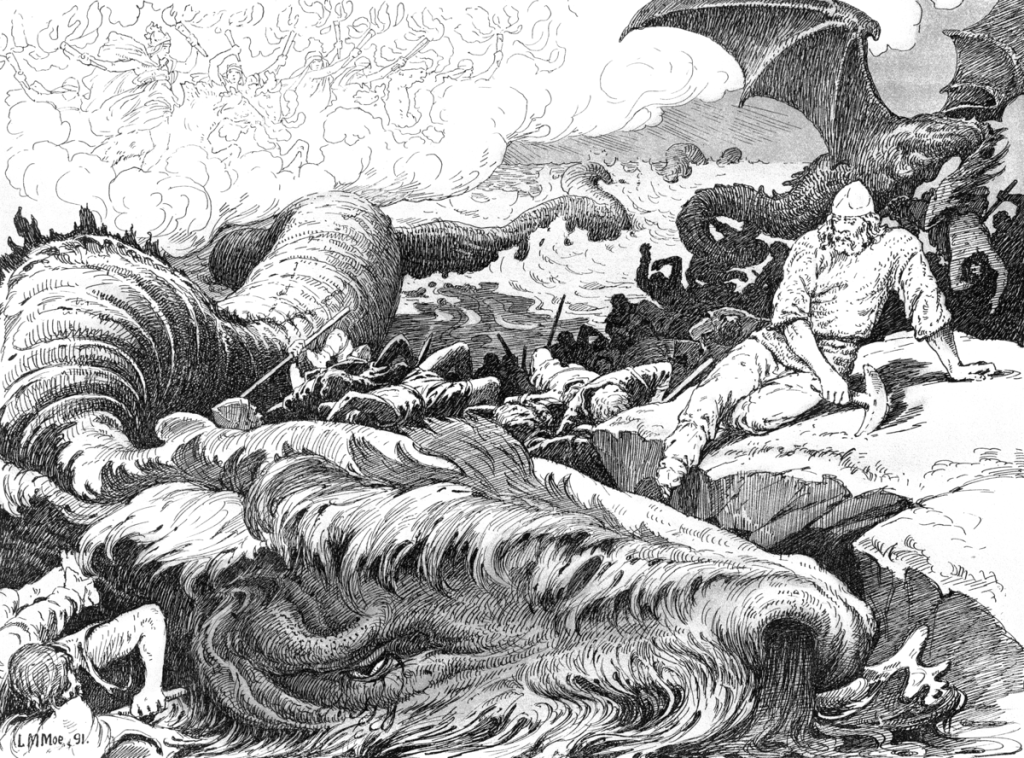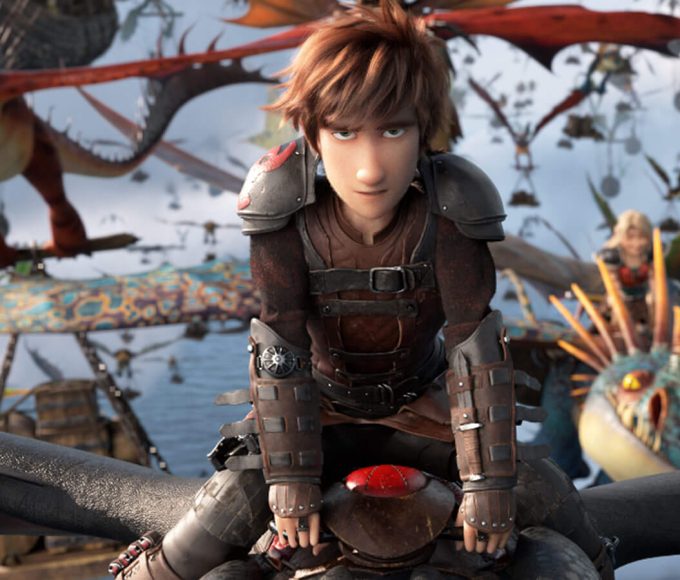In Norse tales, Loki is infamous for his cunning and the monstrous progeny he sired. His children, like the mighty wolf Fenrir and the mysterious underworld goddess Hel, mirror his duality—capable of both creation and chaos. This post highlights the significant role of Loki’s children in Norse lore, emphasizing their father’s multifaceted legacy.
I. Loki: The God of Deceit and Magic
Loki, a prominent figure in Norse mythology, is known as the god of deceit and magic. He is complex and multifaceted, embodying both the capacity for great mischief and the ability to assist the gods in their endeavors. Despite his occasional alignment with the gods, Loki’s true nature is that of a disruptor, often sowing chaos and discord among the divine beings and mortals alike.

II. Children of Loki and Sigyn
Sigyn is a god in Norse mythology who is a very loyal mate. During Loki’s punishment, she used a bowl to catch the constant dripping of viper venom to ease Loki’s pain. She and Loki had two sons Narfi or Nari and Váli.

1. Narfi: Son of Loki
In Norse mythology, Narfi is the son of Loki, also known as Nari. Narfi inherited many of his father’s traits, most notably the ability to shape-shift and transform into any creature or object. Like his father, he was known for his cunning and resourcefulness. Still, his stories are filled with mischief and reckless behavior rather than grand conspiracies affecting the entire universe like Loki’s.
Very little is said about him, and depending on the version, he ends up differently. According to Gylfaginning he was called Nari and was killed by his other brother Váli, who turned into a wolf. But in the Lokasenna, it is again said that Narfi turned into a wolf and was killed by his brother Nari. But the well-known story is that when Loki was punished, it was the entrails of their son Nari that bound him, and Váli was turned into a wolf.
2. Váli: The Avenger of His Father
Váli is one of Loki’s children and has a place in the colorful history of Norse mythology. However, according to various versions of Norse mythology, one of Odin’s children is also called Váli. Váli plays an important role in the myth, especially in the events surrounding the punishment of his father Loki. Although very little is written about him, we can assume that Váli is a character full of contradictions. He has the cunning and wit of Loki, but also his own unique courage and determination. His life was full of challenges and adventures, and his actions influenced not only his father but the entire mythological world.
III. Children of Loki and Angrboða
Angrboða, also known as Angrboda, is a Jötunn in Norse mythology. She was Loki’s mate and bore him three fearsome children: Fenrir, Jörmungandr, and Hel. Each child inherited their father’s cunning and their mother’s great brute strength.

1. The Wolf Fenrir: The Fiercest Beast
Fenrir, also known as Fenrisúlfr, Hróðvitnir, and Vánagandr, is recognized as the mightiest wolf in Norse mythology and one of Loki’s children. Embodying ferocity, Fenrir is deeply feared by all the gods.
The ancient Prose Edda recounts a legend that is both profound and warlike. In this tale, the great wolf Fenrir, famed for his unmatched strength and fierceness, audaciously bit off the right hand of Týr, the god of war. This heinous act not only underscores Týr’s bravery in his fearless sacrifice but also accentuates Fenrir’s pivotal role in the Twilight of the Gods (Ragnarök).
In Norse mythology, Fenrir, a ferocious wolf, actively plays a significant role in the events that lead up to Ragnarök, the end of the world. It is said that Fenrir will cause widespread destruction and the death of Odin, the Allfather. To prevent the unleashing of his destructive power, the gods took the initiative to bind him with Gleipnir, a chain deemed unbreakable. However, when the Twilight of the Gods arrives, Fenrir breaks free and joins the climactic battle.

2. Jörmungandr: The World Serpent
Jörmungandr is one of the children of Loki. It is also known as the Midgard Serpent or the World Serpent and is described as a very large sea serpent.
Jörmungandr’s birth was accompanied by a prophecy that he would grow into a creature of great power. So Odin threw Jörmungandr into the surrounding seas of Midgard to prevent him from causing chaos in the world.
However, Jörmungandr was large enough to encircle the entire world and to bite off its tail, much like an armored serpent.
While in Ragnarök, Jörmungandr had his final battle with Thor, the God of Thunder. This battle usually ends in a lose-lose situation: Thor kills the giant serpent but is injured by the effects of its venom, causing him to die shortly after the serpent’s demise.

3. Hel: Goddess of the Underworld
Hel, as one of Loki’s children, plays an important goddess role in Norse mythology. Her name is closely associated with the underworld, Helheim.
Because of the prophecy, Odin threw Hel into Niflheim and granted her powers. Hel’s realm is said to be the place where the souls of those who die of sickness or old age reside. It is a cold, dreary place, often depicted as half in light and half in darkness, reflecting the duality of life and death. Hel rules this realm with fairness and impartiality, ensuring that souls are laid to rest in the afterlife.
The story most associated with her is the Baldr incident. After Baldr’s death, his mother Frigg sends Hermóðr to Helheim to ask Hel to release Baldr back into the world of the living. Hel agrees to let Baldr return if the world weeps for him. However, all the living wept for Baldr except Þökk (presumably to be Loki in disguise). Therefore, Baldr had to stay in Helheim.

IV. Children of Loki and Svaðilfari
Svaðilfari is a massive and robust stallion in Norse mythology, renowned for his pivotal role in the story of constructing the walls of Asgard. He is the parent, along with Loki, of Sleipnir, the legendary eight-legged horse.
Sleipnir: Odin’s Eight-Legged Steed
Sleipnir is one of Loki’s children. It was Odin’s mount, known for its unique eight legs, which made it one of the fastest creatures in mythology. Sleipnir was said to be able to travel through air and water and run at incredible speeds in even the harshest weather conditions. This horse is not only a symbol of speed but also of strength and endurance.
In the prose Edda, a story is told of an unknown builder who offered to propose the construction of a fortification for mankind. This would help to ward off invaders. But in exchange, he asked the gods for Freya, the sun, and the moon. After much debate, the gods agreed to the offer but placed several restrictions on the builder. But this builder had a very powerful stallion, Svaðilfari, who could drag huge rocks. The gods asked Loki to help to prevent this builder from finishing. Loki then turned into a mare and seduced Svaðilfari, delaying the construction. The builder was later identified as jötunn, and Thor killed him. Later, Loki gave birth to Sleipnir, an eight-legged grey colt.

V. Conclusion: The Enduring Impact of Loki’s Offspring
Loki’s children, embodiments of their father’s cunning and power, play pivotal roles in Norse mythology. Their stories reflect the delicate balance between order and chaos, shaping the cosmos and the gods’ ultimate fate. Their influence is profound, a reminder of the lasting impact that the trickster’s lineage has on the mythological world.
For those intrigued by the symbolism of Loki and his tales, we invite you to explore our previous articles. Additionally, for those interested in Norse-inspired artifacts, there are numerous exquisite jewelry available that capture the essence of this rich mythology.
Aria
Aria is an effervescent writer with a profound passion for the written word. Holding an academic degree in British Literature, her journey through the realm of literature, art, and human emotions is as enchanting as her narratives. Join her as she pens stories that soar beyond boundaries, embracing the essence of art in its purest form. Through her writing, Aria invites you to embark on a journey of emotional discovery and aesthetic wonder.
Recent Posts
A Guide to How to Train Your Dragon Species
06/24/2025How to Style Baggy Jeans
06/17/2025Grunge Aesthetic: A Style Revolution
06/03/2025What Is Health Goth
05/27/2025Categories
Related Articles
A Guide to How to Train Your Dragon Species
Welcome, fellow dragon enthusiasts and aspiring Viking trainers! Have you ever wondered...
ByAlicia06/24/2025Grunge Aesthetic: A Style Revolution
The world of fashion is a cyclical beast, constantly re-inventing and re-interpreting...
ByAlicia06/03/2025What Is Health Goth
In 2024, “Health Goth” which is hot in 2010s gets back from...
ByAlicia05/27/2025Dragon Rings: From Mythology to Modern Symbolism
The dragon, a mythical creature revered across cultures, has long been a...
ByAlicia03/18/2025












Leave a comment